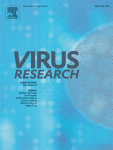Ver ítem
- xmlui.general.dspace_homeCentros e Institutos de InvestigaciónCICVyA. Centro de Investigación en Ciencias Veterinarias y AgronómicasInstituto de VirologíaArtículos científicosxmlui.ArtifactBrowser.ItemViewer.trail
- Inicio
- Centros e Institutos de Investigación
- CICVyA. Centro de Investigación en Ciencias Veterinarias y Agronómicas
- Instituto de Virología
- Artículos científicos
- Ver ítem
Detection, molecular characterization and phylogenetic analysis of G3P[12] and G14P[12] equine rotavirus strains co-circulating in central Kentucky
Resumen
Equine rotavirus A (ERVA) is the leading cause of diarrhea in neonatal foals and a major health problem to the equine breeding industry worldwide. The G3P[12] and G14P[12] ERVA genotypes are the most prevalent in foals with diarrhea. Control and prevention strategies include vaccination of pregnant mares with an inactivated vaccine containing a prototype ERVA G3P[12] strain with limited and controversial field efficacy. Here, we performed the molecular
[ver mas...]
Equine rotavirus A (ERVA) is the leading cause of diarrhea in neonatal foals and a major health problem to the equine breeding industry worldwide. The G3P[12] and G14P[12] ERVA genotypes are the most prevalent in foals with diarrhea. Control and prevention strategies include vaccination of pregnant mares with an inactivated vaccine containing a prototype ERVA G3P[12] strain with limited and controversial field efficacy. Here, we performed the molecular characterization of ERVA strains circulating in central Kentucky using fecal samples collected during the 2017 foaling season. The data indicated for the first time that the G14P[12] genotype is predominant in this region in contrast to a previous serotyping study where only G3 genotype strains were reported. Overall, analysis of antigenic sites in the VP7 protein demonstrated the presence of several amino acid substitutions in the epitopes exposed on the surface including a non-conserved N-linked glycosylation site (D123N) in G14P[12] strains, while changes in antigenic sites of VP8* were minor. Also, we report the successful isolation of three ERVA G14P[12] strains which presented a high identity with other G14 strains from around the world. These may constitute ideal reference strains to comparatively study the molecular biology of G3 and G14 strains and perform vaccine efficacy studies following heterologous challenge in the future.
[Cerrar]

Autor
Carossino, Mariano;
Barrandeguy, Maria Edith;
Li, Yanqiu;
Parreño, Viviana;
Janes, Jennifer;
Loynachan, Alan T.;
Balasuriya, Udeni B.R.;
Fuente
Virus research 255 : 39-54. (15 August 2018)
Fecha
2018
Editorial
Elsevier
ISSN
0168-1702
Formato
pdf
Tipo de documento
artículo
Palabras Claves
Derechos de acceso
Abierto
 Excepto donde se diga explicitamente, este item se publica bajo la siguiente descripción: Creative Commons Attribution-NonCommercial-ShareAlike 2.5 Unported (CC BY-NC-SA 2.5)
Excepto donde se diga explicitamente, este item se publica bajo la siguiente descripción: Creative Commons Attribution-NonCommercial-ShareAlike 2.5 Unported (CC BY-NC-SA 2.5)


